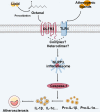Olfactory receptor 2 activation in macrophages: novel mediator of atherosclerosis progression
- PMID: 35864109
- PMCID: PMC9304343
- DOI: 10.1038/s41392-022-01115-7
Olfactory receptor 2 activation in macrophages: novel mediator of atherosclerosis progression
Conflict of interest statement
The authors declare no competing interests. Dao Wen Wang is the editorial board member of
Figures

Comment on
-
Olfactory receptor 2 in vascular macrophages drives atherosclerosis by NLRP3-dependent IL-1 production.Science. 2022 Jan 14;375(6577):214-221. doi: 10.1126/science.abg3067. Epub 2022 Jan 13. Science. 2022. PMID: 35025664 Free PMC article.
References
Publication types
MeSH terms
Substances
LinkOut - more resources
Full Text Sources
Medical

